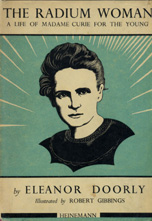The Radium Woman facts for kids

Cover of the first edition
|
|
| Author | Eleanor Doorly |
|---|---|
| Illustrator | Robert Gibbings |
| Cover artist | Gibbings |
| Country | United Kingdom |
| Language | English |
| Subject | Marie Curie |
| Genre | Biography for children |
| Publisher | Heinemann |
|
Publication date
|
1939 |
| Media type | Print (hardcover) |
| Pages | 181 pp (first edition) |
| ISBN | 0435120077 (1970?) |
| OCLC | 558179914 |
| LC Class | QD22.C8 D6 1940 |
The Radium Woman is a special book about the famous scientist Marie Curie. It was written by Eleanor Doorly for young people. This book is based on a longer biography by Marie's daughter, Ève Curie. It was published in 1939 and includes cool woodcut pictures by Robert Gibbings.
Eleanor Doorly and The Radium Woman won a big award called the Carnegie Medal. This award is given each year for the best children's book by a British subject. It's quite rare for a non-fiction book to win this honor.
The book was republished in 2006 by Hesperides Press.
Contents
About the Book's Start
Why This Book Was Written
The Radium Woman was inspired by Ève Curie's biography of her mother. That original book came out in many countries in 1937. Eleanor Doorly explained why she wrote this version for young readers.
She said that Marie Curie's life story was told beautifully by her daughter. Doorly felt very humble to make a shorter version for young people. She believed that kids shouldn't have to wait until they are older than sixteen to learn about amazing people. She wanted them to hear about great deeds and wonderful human beings sooner.
Marie Curie's Early Life
Growing Up in Poland
The first part of the book talks about Marie Curie's early life. She grew up in Poland, which was then controlled by the Russian Empire. The story begins when Marie, named Manya Sklodovski, was five years old. Even then, she knew about the power of the Russian officials.
Later, when she was ten, the book describes her secret lessons. She and her classmates learned forbidden Polish history. The book paints a clear picture of her surroundings and important moments. It shows how brilliant she was from a young age.
Teenage Years and Challenges
Other chapters share more about Manya's life. When she was fourteen, she learned that a friend's brother would be executed as a rebel. After finishing high school at sixteen, she took a year-long holiday. She spent this time in the countryside and mountains.
The book continues through her early struggles to earn a living. She taught to support her sister, who was studying medicine in Paris. Manya also started an illegal Polish school for peasant children in the countryside. She even went through an unhappy love affair.
After a short time in Belgium, she began her own studies. She studied both in Paris and in Warsaw. The book says that Marie loved her hard student days the most. Even though she was poor and alone, she felt most like herself during that time.
Discoveries and Awards
The middle chapters of the book focus on her meeting with Pierre Curie. This led to their marriage and the start of her amazing career. It also covers their great discoveries that changed science forever. These discoveries earned them the Nobel Prize.
Throughout these parts, the book includes details about her daily life. It shares small, important moments to make the story exciting for young readers.
The Carnegie Medal Award
How the Award Was Given
The Carnegie Medal is a very important award. According to one history of the Library Association, the committee first decided not to give an award in 1939. This decision was made in early 1940. It was influenced by some recent criticism and the start of World War II.
However, the award for Eleanor Doorly and The Radium Woman was still given. It was decided "over the heads of the committee," meaning someone higher up made the final choice.

